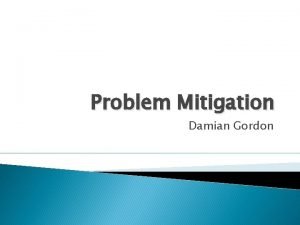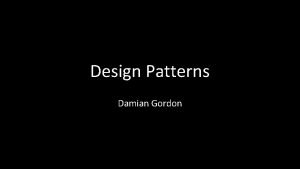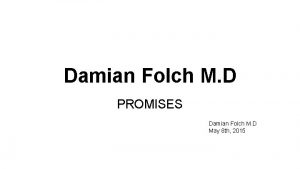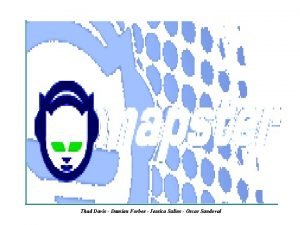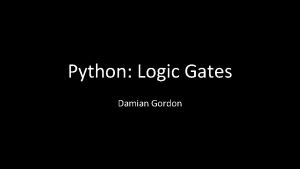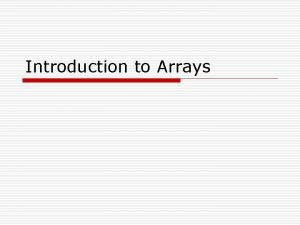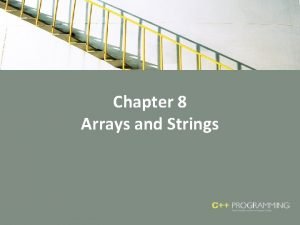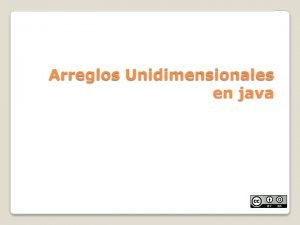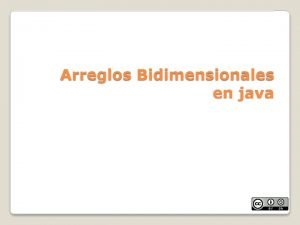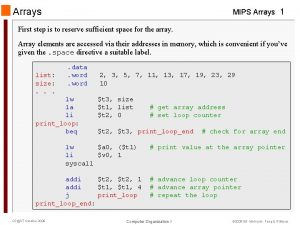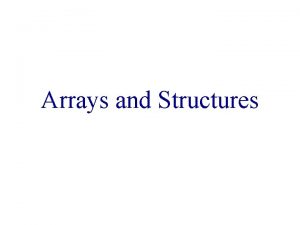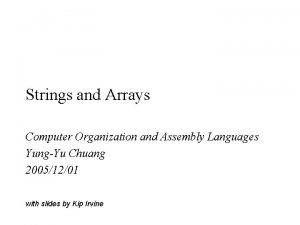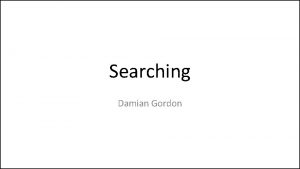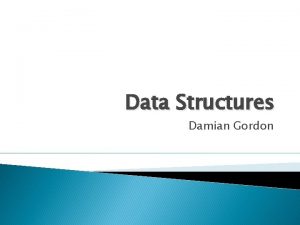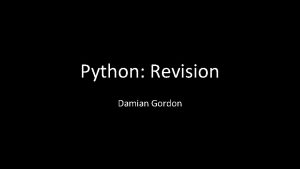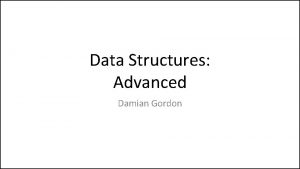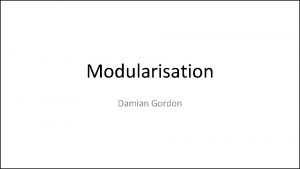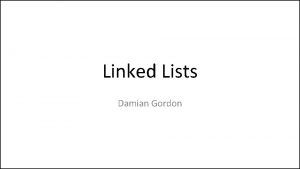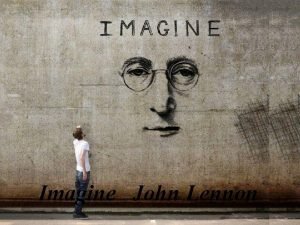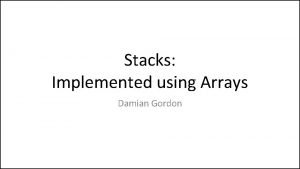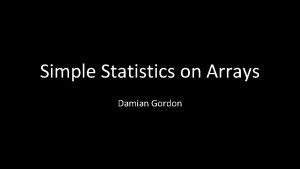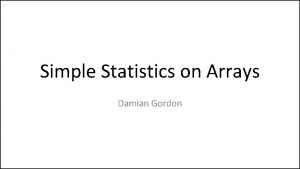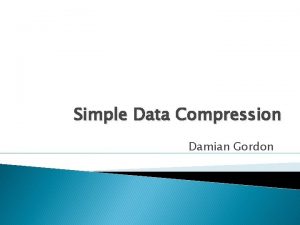Data Structures Arrays Damian Gordon Arrays Imagine we




![Arrays • We declare an array as follows: • Integer Age[40]; Arrays • We declare an array as follows: • Integer Age[40];](https://slidetodoc.com/presentation_image/1b40d463f12809cca923c5fcc0309b54/image-5.jpg)
![Arrays • We declare an array as follows: • Integer Age[40]; • Which means Arrays • We declare an array as follows: • Integer Age[40]; • Which means](https://slidetodoc.com/presentation_image/1b40d463f12809cca923c5fcc0309b54/image-6.jpg)
![Arrays • We declare an array as follows: • Integer Age[40]; • Which means Arrays • We declare an array as follows: • Integer Age[40]; • Which means](https://slidetodoc.com/presentation_image/1b40d463f12809cca923c5fcc0309b54/image-7.jpg)












![Arrays • We could do it like this: PROGRAM Add 1 To. Age: Age[0] Arrays • We could do it like this: PROGRAM Add 1 To. Age: Age[0]](https://slidetodoc.com/presentation_image/1b40d463f12809cca923c5fcc0309b54/image-20.jpg)























- Slides: 43

Data Structures: Arrays Damian Gordon

Arrays • Imagine we had to record the age of everyone in the class, we could do it declaring a variable for each person.

Arrays • Imagine we had to record the age of everyone in the class, we could do it declaring a variable for each person. • E. g. – Integer – Integer – etc. Age 1; Age 2; Age 3; Age 4; Age 5;

Arrays • But if there was a way to collect them all together, and declare a single special variable for all of them, that would be quicker. • We can, and the special variable is called an ARRAY.
![Arrays We declare an array as follows Integer Age40 Arrays • We declare an array as follows: • Integer Age[40];](https://slidetodoc.com/presentation_image/1b40d463f12809cca923c5fcc0309b54/image-5.jpg)
Arrays • We declare an array as follows: • Integer Age[40];
![Arrays We declare an array as follows Integer Age40 Which means Arrays • We declare an array as follows: • Integer Age[40]; • Which means](https://slidetodoc.com/presentation_image/1b40d463f12809cca923c5fcc0309b54/image-6.jpg)
Arrays • We declare an array as follows: • Integer Age[40]; • Which means we declare 40 integer variables, all can be accessed using the Age name. ……. . …
![Arrays We declare an array as follows Integer Age40 Which means Arrays • We declare an array as follows: • Integer Age[40]; • Which means](https://slidetodoc.com/presentation_image/1b40d463f12809cca923c5fcc0309b54/image-7.jpg)
Arrays • We declare an array as follows: • Integer Age[40]; • Which means we declare 40 integer variables, all can be accessed using the Age name. 0 1 2 3 4 5 6 7 ……. . … 38 39

Arrays 0 1 2 3 4 5 6 7 44 23 42 33 16 - - 34 18 ……. . … 38 39 34 82

Arrays 0 1 2 3 4 5 6 7 44 23 42 33 16 - - 34 18 • So if I do: • PRINT Age[0]; • We will get: • 44 ……. . … 38 39 34 82

Arrays 0 1 2 3 4 5 6 7 44 23 42 33 16 - - 34 18 • So if I do: • PRINT Age[2]; • We will get: • 42 ……. . … 38 39 34 82

Arrays 0 1 2 3 4 5 6 7 44 23 42 33 16 - - 34 18 • So if I do: • PRINT Age[39]; • We will get: • 82 ……. . … 38 39 34 82

Arrays 0 1 2 3 4 5 6 7 44 23 42 33 16 - - 34 18 ……. . … • So if I do: • PRINT Age[40]; • We will get: • Array Out of Bounds Exception 38 39 34 82

Arrays 0 1 2 3 4 5 6 7 44 23 42 33 16 - - 34 18 ……. . … • We notice that Age[5] is blank. • If I want to put a value into it (e. g. 54), I do: • Age[5] <- 54; 38 39 34 82

Arrays 0 1 2 3 4 5 6 7 44 23 42 33 16 54 34 18 ……. . … • We notice that Age[5] is blank. • If I want to put a value into it (e. g. 54), I do: • Age[5] <- 54; 38 39 34 82

Arrays • We can think of an array as a series of pigeon-holes:

Array 1 0 3 6 9 12 15 18 4 7 10 13 16 19 2 5 8 11 14 17 20

Arrays • If we look at our array again: 0 1 2 3 4 5 6 7 44 23 42 33 16 54 34 18 ……. . … 38 39 34 82

Arrays • If we wanted to add 1 to everyone’s age: 0 1 2 3 4 5 6 7 44 23 42 33 16 54 34 18 +1 +1 ……. . … 38 39 34 82 +1 +1

Arrays • If we wanted to add 1 to everyone’s age: 0 1 2 3 4 5 6 7 45 24 43 34 17 55 35 19 ……. . … 38 39 35 83
![Arrays We could do it like this PROGRAM Add 1 To Age Age0 Arrays • We could do it like this: PROGRAM Add 1 To. Age: Age[0]](https://slidetodoc.com/presentation_image/1b40d463f12809cca923c5fcc0309b54/image-20.jpg)
Arrays • We could do it like this: PROGRAM Add 1 To. Age: Age[0] <- Age[0] + 1; Age[1] <- Age[1] + 1; Age[2] <- Age[2] + 1; Age[3] <- Age[3] + 1; Age[4] <- Age[4] + 1; Age[5] <- Age[5] + 1; …………………………… Age[38] <- Age[38] + 1; Age[39] <- Age[39] + 1; END.

Arrays • An easier way of doing it is: PROGRAM Add 1 To. Age: N <- 0; WHILE (N != 40) DO Age[N] <- Age[N] + 1; N <- N + 1; ENDWHILE; END.

Arrays • Or: PROGRAM Add 1 To. Age: FOR N IN 0 TO 39 DO Age[N] <- Age[N] + 1; ENDFOR; END.

Arrays • If we want to add up all the values in the array:

Arrays • If we want to add up all the values in the array: PROGRAM Total. Of. Array: integer Total <- 0; FOR N IN 0 TO 39 DO Total <- Total + Age[N]; ENDFOR; END.

Arrays • So the average is:

Arrays • So the average is: PROGRAM Average. Of. Array: integer Total <- 0; FOR N IN 0 TO 39 DO Total <- Total + Age[N]; ENDFOR; PRINT Total/40; END.

Arrays • We can add another variable: PROGRAM Average. Of. Array: integer Total <- 0; integer Array. Size <- 40; FOR N IN 0 TO 39 DO Total <- Total + Age[N]; ENDFOR; PRINT Total/40; END.

Arrays • We can add another variable: PROGRAM Average. Of. Array: integer Total <- 0; integer Array. Size <- 40; FOR N IN 0 TO 39 DO Total <- Total + Age[N]; ENDFOR; PRINT Total/Array. Size; END.

Arrays • We can add another variable: PROGRAM Average. Of. Array: integer Total <- 0; integer Array. Size <- 40; FOR N IN 0 TO Array. Size-1 DO Total <- Total + Age[N]; ENDFOR; PRINT Total/Array. Size; END.

Arrays • So now if the Array size changes, we just need to change the value of one variable (Array. Size). PROGRAM Average. Of. Array: integer Total <- 0; integer Array. Size <- 40; FOR N IN 0 TO Array. Size-1 DO Total <- Total + Age[N]; ENDFOR; PRINT Total/Array. Size; END.

Arrays • We can also have an array of real numbers:

Arrays • We can also have an array of real numbers: 0 1 2 3 4 5 22. 00 65. 50 -2. 20 78. 80 54. 00 -3. 33 6 0. 00 7 47. 65

Arrays • What if we wanted to check who has a balance less than zero : PROGRAM Less. Than. Zero. Balance: integer Array. Size <- 8; FOR N IN 0 TO Array. Size-1 DO IF Bank. Balance[N] < 0 THEN PRINT “User” N “is in debt”; ENDIF; ENDFOR; END.

Arrays • We can also have an array of characters:

Arrays • We can also have an array of characters: 0 1 2 3 4 5 6 7 G A T T C C A G ……. . … 38 39 A A

Arrays • What if we wanted to count all the ‘G’ in the Gene Array: 0 1 2 3 4 5 6 7 G A T T C C A G ……. . … 38 39 A A

Arrays • What if we wanted to count all the ‘G’ in the Gene Array: PROGRAM Average. Of. Array: integer Array. Size <- 40; integer G-Count <- 0; FOR N IN 0 TO Array. Size-1 DO IF Gene[N] = ‘G’ THEN G-Count <- G-Count + 1; ENDIF; ENDFOR; PRINT “The total G count is: ” G-Count; END.

Arrays • What if we wanted to count all the ‘A’ in the Gene Array: PROGRAM Average. Of. Array: integer Array. Size <- 40; integer A-Count <- 0; FOR N IN 0 TO Array. Size-1 DO IF Gene[N] = ‘A’ THEN A-Count <- A-Count + 1; ENDIF; ENDFOR; PRINT “The total A count is: ” A-Count; END.

Arrays • We can also have an array of strings:

Arrays • We can also have an array of strings: 0 Dog 1 2 Cat Dog 3 Bird 4 Fish 5 Fish 6 7 Cat

Arrays • We can also have an array of booleans:

Arrays • We can also have an array of booleans: 0 1 2 3 4 5 6 7 TRUE FALSE

etc.
 Imagine and explore
Imagine and explore Damian gordon
Damian gordon Damian hacks
Damian hacks Damian gordon
Damian gordon What are the disadvantages of arrays
What are the disadvantages of arrays Parallel arrays java
Parallel arrays java Analogous structure
Analogous structure Damian sturzaker
Damian sturzaker Padre damian de veuster 2215 vitacura
Padre damian de veuster 2215 vitacura Ejemplo de biografía de una persona
Ejemplo de biografía de una persona Padre damian de veuster 2215
Padre damian de veuster 2215 Damian clancy
Damian clancy Damian krysztofik
Damian krysztofik Dr damian folch
Dr damian folch Damian urbańczyk żona
Damian urbańczyk żona Christophe damian
Christophe damian Damian mac
Damian mac What did fray damian massanet do
What did fray damian massanet do Padre damian de veuster 2215 vitacura
Padre damian de veuster 2215 vitacura Padre damian de veuster 2215
Padre damian de veuster 2215 Damian harding
Damian harding Damian urbańczyk wikipedia
Damian urbańczyk wikipedia Damian topolski
Damian topolski Oscar sandoval md
Oscar sandoval md Damian heywood
Damian heywood Melissa damian
Melissa damian стивен марли muzičar
стивен марли muzičar Damian czudek
Damian czudek Dana damian
Dana damian Iru academy
Iru academy Python logic gate simulator
Python logic gate simulator Damian sommerville
Damian sommerville Array of arrays c++
Array of arrays c++ Java array operations
Java array operations Veteork
Veteork C++ parallel arrays
C++ parallel arrays Why do we need arrays?
Why do we need arrays? Dynamic arrays and amortized analysis
Dynamic arrays and amortized analysis Arreglos unidimensionales en java
Arreglos unidimensionales en java Arrays bidimensionales java
Arrays bidimensionales java Array mips
Array mips Polynomial representation using arrays
Polynomial representation using arrays Array of strings assembly
Array of strings assembly Global arrays in c
Global arrays in c

